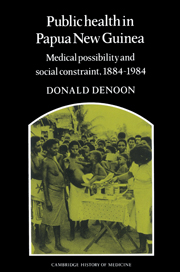Book contents
- Frontmatter
- Contents
- Acknowledgements
- Maps of Papua New Guinea
- Introduction
- I The rise and fall of tropical medicine
- 1 Pre-colonial health and disease
- 2 The administration of public health
- 3 Early colonial medical administration
- 4 The political economy of health in Papua between the wars
- 5 The political economy of health in New Guinea between the wars
- 6 Medical education
- 7 The Pacific War: the condition of the people
- II The rise and fall of the great campaigns
- Notes
- Bibliography
- Index
3 - Early colonial medical administration
Published online by Cambridge University Press: 11 February 2010
- Frontmatter
- Contents
- Acknowledgements
- Maps of Papua New Guinea
- Introduction
- I The rise and fall of tropical medicine
- 1 Pre-colonial health and disease
- 2 The administration of public health
- 3 Early colonial medical administration
- 4 The political economy of health in Papua between the wars
- 5 The political economy of health in New Guinea between the wars
- 6 Medical education
- 7 The Pacific War: the condition of the people
- II The rise and fall of the great campaigns
- Notes
- Bibliography
- Index
Summary
Before colonial administration was attempted, it was already clear that Europeans and their servants would suffer acutely from malaria, and in some circumstances from dysentery. The first resident European, the Russian scientist (and disciple of Tolstoy), Nikolai Nikolayevich Miklouho-Maclay, was conveyed to the north coast in 1871, with two man-servants. The Polynesian soon died, and the surviving Swede fell chronically ill. Maclay's health was seriously undermined, and he concluded that
It is not the Papuans or the tropical heat or the impassable forests that guard the coasts of New Guinea. Their mighty ally protecting them from foreign invaders is the pale cold, first shivering and then burning fever.
Within a few months, the Polynesian pastors and teachers established on the coast of the Papuan Gulf by the London Missionary Society, had to endure devastating mortality rates from malaria. They were familiar with mosquitoes – perhaps too familiar – but not with anopheles, and took quite inadequate precautions. And from the late 1870s there was a series of gold rushes from northern Australia. The prospectors were casual and hasty in arranging sanitation, and fell like nine-pins to dysentery. One vivid account (from a slightly later date, 1889) describes the complete collapse of a whole mining community
- Type
- Chapter
- Information
- Public Health in Papua New GuineaMedical Possibility and Social Constraint, 1884–1984, pp. 25 - 32Publisher: Cambridge University PressPrint publication year: 1989



